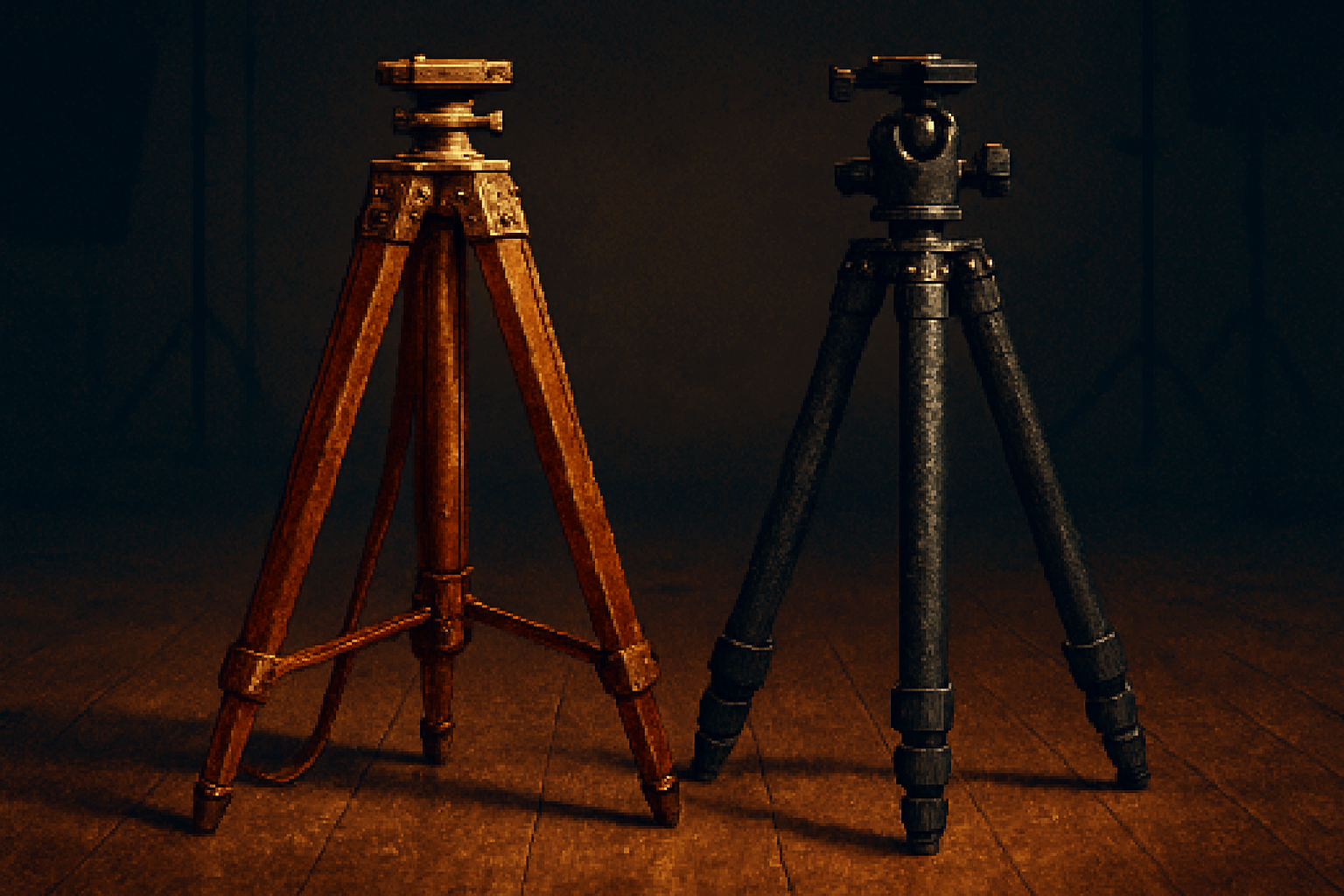· retrotech · 7 min read
The Evolution of Tripods: From Vintage to Modern Marvels
A journey from heavy wooden stands with brass fittings to featherlight carbon-fiber tripods and motorized gimbals - how design, materials, and needs reshaped the humble three-legged support.

I still remember the first time I hefted a century-old wooden tripod out of a museum case. It was heavier than my first camera and smelled faintly of shellac and long-forgotten studios. The brass hardware had a soft, patient resilience - the kind only time and use can manufacture. It felt like an heirloom. It also felt horribly impractical for a hike up a ridge with a telephoto lens.
Tripods are where aesthetics and engineering argue most politely. They stand rigid and forgiving while photographers borrow their stability for the briefest moments of capture. Their evolution - from stout wooden legs to sleek carbon-fiber columns with motorized heads - is an archetypal story of photography itself: portability wrestles with permanence; craftsmanship is pressured by industrial materials; and standards are enforced by markets and photographers who just want a quick-release plate that actually releases.
A three-legged beginning: 19th-century honesty
Early photographic tripods were essentially camera adaptations of surveyor stands and painters’ easels. Wood and brass, the materials of choice, were abundant, familiar, and worked easily with hand tools. These tripods told you a few things plainly:
- They were built to last. Solid hardwood legs, dovetailed joints, and brass fittings lasted decades.
- They prioritized stability over portability. Photographers accepted bulk for the sake of vibration-free exposures.
Why wood? Wood damps vibration naturally and-when well-made-has a warmth and aesthetic that metal lacks. Brass fittings resisted corrosion and could be machined to precise tolerances with the technology of the day. These tripods are the reason some portrait studios in the early 20th century looked like small furniture workshops.
For further reading on the general history of photographic tripods, see: Tripod (photography).
Industrial materials and mass market: the 20th century
The mid-20th century introduced two big changes: new materials (aluminum and steel tubing) and mass production. Aluminum made tripods lighter and cheaper to produce. Leg joints, center columns, and quick-release mechanisms began to appear as standard features.
Key innovations of this era included:
- Leg locks - twist-locks and flip-lever locks replaced threaded collars on many consumer tripods, speeding set-up.
- Center columns - added height flexibility (and also an annoying resonance if you weren’t careful).
- Quick-release plates - cameras could snap on and off without screwing directly into the tripod head, a transformative convenience.
This is also when specialized heads gained popularity: 3-way pan heads for precise control, and ball heads for speed and freedom of movement. The market bifurcated - heavy-duty studio stands for large-format work, and lighter, portable tripods for field photographers.
Important companies like Manfrotto and Gitzo helped industrialize tripod design and distribution; they expanded the available options for hobbyists and professionals alike (Manfrotto, Gitzo).
Modularity, standards, and the Arca-Swiss moment
As photographers accumulated accessories and swapped gear, the need for common standards became obvious. Enter plate standards and modular heads.
Arca-Swiss-style plates emerged as a de facto standard for quick-release clamps in the late 20th century, simplifying compatibility across heads and plates. See Arca-Swiss.
Thread standards (1/4”-20 and 3/8”-16), spiked feet for outdoor use, and leveling bases became everyday features.
Modularity meant you could buy a stout tripod, then swap in a ball head for hiking or a geared head for architectural work. The tripod stopped being a single-purpose tool and became a camera system’s stable backbone.
Carbon fiber, composites, and the modern obsession with weight
Late 20th and early 21st centuries introduced carbon-fiber reinforced polymers into tripod legs. This was not merely a lightness fetish - carbon fiber offers an exceptional stiffness-to-weight ratio and natural vibration damping. The trade-offs are cost and (sometimes) fragility in certain impact scenarios.
Why carbon fiber matters:
- It reduces fatigue on long shoots and long approaches.
- It can be manufactured with differing layups to tune stiffness and vibration characteristics.
- It resists corrosion and moisture in ways metal sometimes doesn’t.
For a technical background on carbon-fiber materials, see: Carbon fiber reinforced polymer.
Fluid heads, gimbals, and motorized systems: the video revolution
Still photography demanded stability. Video demanded smooth motion. That distinction drove another branch of tripod evolution.
- Fluid heads add controlled drag to pan and tilt, producing cinematic movement rather than jerky adjustments.
- Camera gimbals and motorized heads provide active stabilization and remote control for dynamic shots.
These technologies shifted the tripod from a purely passive support to an active motion tool. The same tripod might serve a travel photographer at dawn and a one-person video team by noon.
For more on modern stabilization systems, see Gimbal (photography).
Design decisions that defined eras (quick checklist)
- Materials - wood & brass → steel/aluminum → magnesium alloys & composites → carbon fiber.
- Joint tech - fixed joints → threaded collars → flip-locks & twist-locks → hybrid quick-set technologies.
- Head types - riser/pan heads → 3-way heads → ball heads → fluid & motorized heads.
- Standards - proprietary plates → Arca-Swiss convergence → increased cross-compatibility.
Why vintage tripods still matter (and why they sell at flea markets)
Vintage tripods are not merely museum curiosities. They remain relevant because they embody values the modern market sometimes forgets:
- Craftsmanship - hand-fitted joints, turned hardwood, solid brass fittings.
- Aesthetics - the patina of age can add quiet dignity to a portrait session.
- Sustainability - vintage materials and repairability beat disposable plastics.
Photographers and designers draw inspiration from vintage stands in three practical ways:
- Reuse and restore - many wooden tripods make excellent bases for modern heads when restored and fitted with the correct thread adapters.
- Design cues - modern manufacturers sometimes mimic wooden flares, brass accents, or even the tactile weight of a classic tripod to signal quality.
- Hybrid builds - artisans create bespoke tripods that combine vintage legs with modern carbon or engineers mount boutique ball heads on antique tripods.
Practical advice: marrying vintage with modern
If you find a lovely old tripod and want to use it today, here’s a compact checklist:
- Inspect the thread size on the mount (typical tripod threads are 1/4”-20 or 3/8”-16) before buying a modern head.
- Check leg integrity - look for splits, delamination (on laminated wood), or rusted metal joints.
- Replace or refurbish worn screws and bushings; antique brass polishes well but don’t overclean - some patina is desirable.
- Consider adding an Arca-Swiss adapter plate or a modern clamp kit to make the tripod compatible with today’s heads.
- Always test load capacity carefully with your heaviest kit before trusting it in the field.
Choosing a tripod today: rules that don’t age
- Know your max load. Your tripod must support the heaviest tool you plan to use, plus a margin.
- Decide your priority - weight or absolute rigidity. You can have both, but it’s expensive.
- Choose the head to match the work - ball heads for run-and-gun, geared heads for precision, fluid heads for video.
- Consider leg-lock type - flip locks are faster; twist locks are cleaner in grit and weather.
The future: smarter, lighter, and a bit more opinionated
Tripods are becoming smarter and more specialized. We’re seeing:
- Integrated electronics - leveling sensors, Bluetooth control, and motorized panning for timelapse.
- Advanced composites - hybrid fiber layups tailor stiffness where needed and save weight elsewhere.
- Ecosystem thinking - systems of plates, heads, clamps, and accessories that lock together seamlessly.
All of which means the humble tripod will continue to oscillate between two poles: the artisanal and the industrial. The artisanal model values repair, beauty, and tactile satisfaction. The industrial model prizes interchangeability, lower cost, and lightness.
Final reflection: what a tripod tells you about a photographer
A tripod is both a tool and a manifesto. The one you carry says what you value - endurance, portability, speed, or the ability to make one perfect, composed frame that demands time. Vintage tripods teach patience and respect for materials; modern tripods teach efficiency and modularity. The best tripod doesn’t simply support your camera. It supports the way you work.
And yes, if you find a vintage wooden tripod that still takes a modern ball head and doesn’t topple under your camera, buy it. It will photograph beautifully and tell better stories than a lot of shiny new kit.
References
- Tripod (photography): https://en.wikipedia.org/wiki/Tripod_(photography)
- Arca-Swiss: https://en.wikipedia.org/wiki/Arca-Swiss
- Manfrotto: https://en.wikipedia.org/wiki/Manfrotto
- Gitzo: https://en.wikipedia.org/wiki/Gitzo
- Carbon fiber reinforced polymer: https://en.wikipedia.org/wiki/Carbon_fiber_reinforced_polymer
- Gimbal (photography): https://en.wikipedia.org/wiki/Gimbal_(photography)



